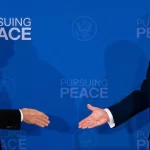
India’s Defence Industrial Mindset needs a Rethink - From Catching Up to Getting Ahead
November 25, 2025

Blog

Study, But Don’t Rush Into Inferences from the Ukraine-Russia War
Posted by admin
Why not follow the Ukraine-Russia Example
- India’s military structure, doctrines and equipment differ significantly from those of either Russia or Ukraine. India’s emphasis on integrated commands, its mix of imported and indigenous weapons and its unique civil-military framework imply a unique approach.
- Ukraine’s challenges stem from a specific set of historical, cultural and geographical factors. India’s strategic environment with two nuclear-armed neighbours and a distinct regional security dynamic demands tailored solutions.
- The Ukraine-Russia war is largely fought in the plains of Eastern Europe, while India’s potential conflicts may involve high-altitude mountain warfare or dense jungle terrain. Different tactical approach, thus.
On 1 June 2025, Ukraine executed a daring drone offensive, codenamed Operation Spiderweb, which targeted multiple Russian airbases deep within Russian territory. Reportedly, it used 117 drones launched from concealed positions within Russia, destroying or damaging over 40 strategic aircraft, including Tu-95 and Tu-22M bombers, as well as an A-50 airborne early warning platform. This unprecedented strike has been likened to a modern-day Pearl Harbor, highlighting the transformative impact of drone warfare on contemporary military strategy. The success of this operation underscores the vulnerabilities of traditional military assets against innovative, low-cost, and agile tactics.
For a country like India, Operation Spiderweb serves as a very relevant case study in the evolving dynamics of warfare. As India navigates its own complex security environment, the lessons from Operation Spiderweb offer valuable insights into the future of defence preparedness and strategic planning.
As we stated in our blog dated 31 May, the recent conflict, Operation Sindoor, set against the backdrop of a region in flux, underscores an important truth: while the tools of warfare may be changing, the fundamental principles that guide military strategy remain constant. Much has been said about the ongoing Ukraine-Russia war and the lessons it offers. India’s military, like most others, is watching closely. From the effective use of drones and precision-guided munitions to the pivotal role of electronic warfare and narrative shaping, these insights are invaluable for future conflicts. But as India charts its own course, it must be careful not to adopt tactics suited to a very different theatre of war.
India’s Human-Centric Warfighting Doctrine. One of the defining features of India’s armed forces has always been their human-centric approach to combat. This emphasis highlights the central role of well-trained, adaptive soldiers and commanders in achieving mission success. India’s operational environment, whether in the rugged mountains of Ladakh or the dense forests of the Northeast, has historically demanded exceptional physical and mental resilience from its troops. This environment requires situational awareness and agile decision-making that no technology can fully replicate. Indian soldiers have consistently demonstrated an ability to improvise and innovate in adverse conditions, a trait that has served the country well in past conflicts.
India’s rich tradition of regimental pride, unit cohesion and decentralised leadership fosters an environment where young field commanders are empowered to take independent decisions. Such flexibility is crucial in fast-changing combat scenarios where centralised commands may be too slow to respond effectively.
As India integrates new technologies like drones, precision-guided munitions and advanced electronic warfare systems, it is essential that these tools do not diminish the primacy of the soldier on the ground. Instead, they must be seen as enablers, amplifying human capabilities rather than substituting them. Training, morale and leadership remain the bedrock of India’s military ethos, and any shift towards technological solutions must preserve these core strengths.
Avoid Overdependence on Technology. The Ukraine-Russia conflict has shown the impressive role of modern technologies, from advanced drones to electronic warfare systems, in shaping battlefield outcomes. A key takeaway is the danger of overdependence on technology. Drones and electronic warfare may offer tactical advantages, but they can also be vulnerable to sophisticated countermeasures, as seen in Operation Sindoor itself when Pakistan’s imported systems faced challenges against India’s layered air defence.
While drones and precision-guided munitions can provide a significant tactical edge, their effectiveness depends greatly on the adversary’s countermeasures and the nature of the terrain. Moreover, electronic warfare can be a double-edged sword; vulnerabilities in electronic systems can be exploited by a technologically savvy adversary. India’s armed forces have a proven record of leveraging human skill, local knowledge and adaptability in difficult environments. Therefore, India must strike a careful balance, integrating new technologies while retaining its emphasis on rigorous training, innovation in the field and decentralised decision-making – some of the qualities that have long been the bedrock of its military effectiveness.
Acquisition of Drones and Autonomous Systems. Our own experiences, combined with lessons from battlefields abroad, almost compel us to acquire modern technology and capabilities, and rightly so. However, resources spent on acquiring these capabilities must be guided by a deliberate and well-thought-out military doctrine, not by knee-jerk reactions, despite the need to fill immediate gaps. Unmanned and autonomous systems, and their counters, must be acquired as part of a networked capability that will provide our forces with an edge over the adversary. Blindly copying others’ experiences seldom works. Thus, No copy – paste solutions.
Use the opportunity to think through a solution that gives us the edge.
In essence, while India must modernise and adopt cutting-edge platforms, it must develop its own doctrine to begin with, and not lose sight of the human element, its biggest asset. The lessons from other conflicts, including Ukraine, reinforce this. Even in the age of drones and AI, it is the ingenuity and spirit of the soldier that often make the critical difference.
Col Ashwani Sharma (retd), Editor
12 Replies to “Study, But Don’t Rush Into Inferences from the Ukraine-Russia War”
Leave a Reply
Search Blog
Categories
Popular Posts







Well written though highly debatable.
1. Primacy of soldier will not be diminished with technology- it will only be enhanced.
2. Days of Dhaawa- Ghop/ Nikaal or brute force Armour are over/ numbered. Inf and Armr have to adopt to cutting edge technologies.
3. “Indian junior ranked soldiers are given a free hand to take decisions in combat ” – Really?
4. I may be entirely wrong, but the paper seems to suggest that technology is a threat to conventional old-school combat.
5. Most important lesson from Ruso – Russo-Ukraine war – drone warfare is here to stay.
Col R Mahesh, Veteran
Valid observations, Mahesh. Thank you.
Point 2 above. We cannot change it overnight. The world’s second-largest army must be dynamic, but in a deliberate and planned manner.
Point 3 – The Kargil war was won by jr leaders who enjoyed considerable autonomy.
Another intresting and innovative aspect was that the Ukrainian, during Operation Spiderweb, used Russian mobile telecommunications networks, specifically 4G and LTE, to remotely control the first-person-view (FPV) drones. These networks provided the necessary bandwidth for real-time video transmission and command inputs, allowing Ukrainian operators to manage drone flights from outside Russian territory.
It paints a grim picture, especially for internal security of India. Drones can be assembled or smuggled in India and could be operated remotely using Indian Telecommunication netwok from Pakistan for terrorist strikes targeting important installations or public gatherings. It will be difficult to establish the culpability or implicity of Pakistan or any Non State Organisation. Security of Nation has become a very complex and demanding tasks needs complete overhaul at all levels.
Yes, Rajan, there’s a lot to learn from this action. But for an army like ours, conventional, well-organised and big, we should build capabilities and well-thought-out actions. This kind of innovation, amazingly effective, is apt for Ukraine – for us, we should plan and prepare and guard against such guerrilla tactics as part of a philosophy
Human-centric warfighting doctrine!
Enunciated anywhere?
The last important change was the Cold Start after the Sundarji Doctrine
The IBG concept started but was not finished
Was Sindoor just a cold start with even less mobilisation?
Maj Gen Bipin Bakshi
Bipin, ours is a human-centric army. Our plans are based on holding ground with troops, while offensive action is based on 1:3 or upto 1:6 ratio in the mountains. All that points towards human human-centric doctrine. We do not talk of replacing men with technology
Well said sir. Read your earlier article too about aims/objs in Ltd wars/ops/conflicts.
Coming back to the U-R conflict, the recent op by Ukraine, however dramatic & brilliant that op may be, it is just one op in a war that’s well over 3 yrs long and counting. The lessons must be drawn, as applicable to us in our environment, in the context of the war as a whole.
From the recent ops, tac lessons to be drawn are from Ukraine’s ability to tpt the drones by ingenious surface means close to the tgt area that is do deep inside Russian territory while maintaining complete surprise. We could certainly be vulnerable to such perfidy by Pak, more so as it is not possible to disperse & park all the tpt ac, refuellers, AWACS, etc in blast pens. They perforce have to be parked on the runways in the open, and hence their vulnerability to such surprise attacks. Regards.
Lt Gen Asit Mistry
Gen Asit, we must guard against similar actions by our adversaries. Once again, I reiterate, a large army like ours must do it as per a deliberate plan
Ashwini, to the point analysis of OP Spider web in the backdrop of OP SINDOOR…yes we have to find a mix and match of new technology versus the adage of Manpower predominant Army( which is a requirement due to the variety of terrains we have and holding every inch of ground as in case of LC/ LAC it becomes important). However, I believe certain procurements of the Drones are already happening and they have been issued down to Bn level in certain formations… though not of WE but through other procurement processes. I feel OP Spider web is going to change how future warfare will be fought. Trench warfare to blitzkrieg to Air land and now Drones. Thanks for sharing your article
Col Sunil Soni, veteran
Thank you for your apt comments, Sunil.
Kursk offensive was launched by Troops and was won back by troops. The primacy of humans will remain in any form of warfare. We need to enmesh the technology as per our requirements. Rightly said, no copy paste solution. Our challenges are different. In a nation where people have to be brought above poverty line, our defense budget will always be a bit tight. Hence prioritization and need of a non- lapsable Capital acct in defense budget.
Well said Gen Jagga. I reiterate that we must plan on our tactical methods and then acquire caability to fight the way we plan to. Adhoc measures will not work for a professional Army like ours, nor is there any need to do so.